Having dipped its toe in New World waters last week to look at Argentina’s best wines, the Listed blog now shifts its attention considerably further North, heading to the Alsace to consider its top five dry whites by Wine Lister score.
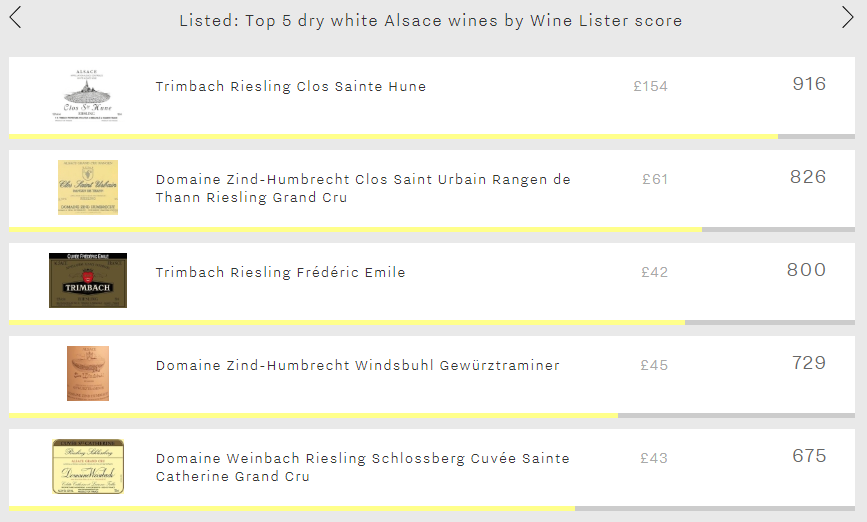
Whilst there was not much between Argentina’s top two wines, in the Alsace it is very much a case of the best and the rest, Trimbach’s flagship Clos Sainte Hune leading by 90 points with a score of 916. Its dominance is thanks to comfortable leads across each of Wine Lister’s rating categories. However, it is in terms of Economics that no other Alsatian wine can get close to it, its score of 804 nearly 120 points ahead of Zind-Humbrecht’s Clos Saint Urbain Rangen de Thann Riesling, whose score of 688 makes it the region’s number two wine in the commercial category. The Clos Sainte Hune’s economic clout is thanks to its higher price (over three times the average of the four other contenders to the Alsatian crown), and trading 2.6 times as many bottles at auction as the others over the past four quarters. As an aside, it is also by far the region’s most searched-for wine online, although its ranking as the 216th most popular wine on Wine Lister perhaps betrays a lack of public interest in Riesling and Alsatian wines in general. Sommeliers are more convinced however, with it featuring in 37% of the world’s top restaurants – which, interestingly, is not the best performance of any Alsatian wine. That accolade goes to its sibling Cuvée Frédéric Emile which manages to pip it to the post in this particular criterion (38%).
Trimbach isn’t the only producer to feature twice in this week’s top five, Zind-Humbrecht’s Clos Saint Urbain Rangen de Thann Riesling (826) and Windsbuhl Gewürztraminer (729) both making the cut. Despite being separated by nearly 100 points overall, they achieve similarly excellent Quality scores, the Clos Saint Urbain Rangen de Thann Riesling leading by just six points (916 vs 910). There isn’t that much between the two in terms of economic performance either, with the Windsbuhl Gewürztraminer sitting 47 points below its stablemate (641 vs 688). Thus the real difference occurs in the Brand category, with the Windsbuhl Gewürztraminer unable to keep pace either in terms of the number of restaurants in which it features (5% vs 16%) or search rank (2,070 vs 928), resulting in a considerably weaker score (546 vs 791). This perhaps confirms that Gewürztraminer, regardless of the quality in the bottle, is a grape that is currently unable to excite either sommeliers or consumers – Zind-Humbrechts’s Windsbuhl languishing in fifth place across both Brand criteria.
The final wine this week is Weinbach’s Riesling Schlossberg Cuvée Sainte Catherine (675). Confirming the outstanding Quality of the Alsace’s top wines, across all vintages it achieves a Quality score of 900. Its overall Wine Lister score is dragged down partly by a lower Brand score (661), but for the most part by a weak Economics score (191). However, if you’re looking for top Quality at a reasonable price, then look no further than its 2014, which qualifies as a Wine Lister Value Pick. Available for as little as £30 per bottle, yet with a Quality score of 944 and predicted to be drinking well for another 15 years, it would definitely be worth seeking out a few bottles of it.
Earlier this year Wine Lister compared the top 50 wines by Quality score from Old World and New. The outcome revealed a 35-point gap between the two, with an average Quality score for the 50 best New World wines of 948. This week, Wine Lister dips its toes back into New World waters to examine the top five Argentinian wines by Wine Lister score.
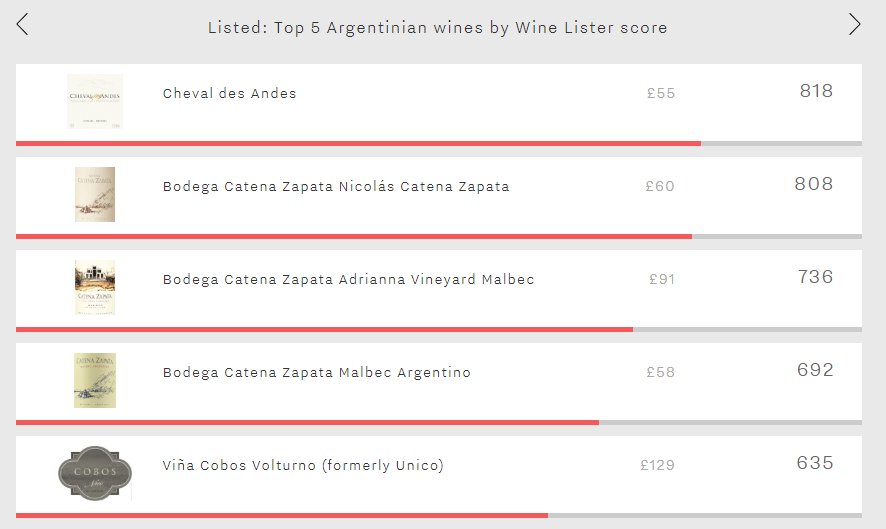
Interestingly, the winner of this week’s top five can perhaps be considered as belonging to both Worlds. Cheval des Andes, the joint venture from Terrazas de los Andes and Pierre Lurton of Cheval Blanc, has an overall Wine Lister score of 818. Unsurprisingly, Cheval des Andes shows the clear benefit of association with its Old World stablemate through a Brand score of 862, the highest of the group. This is thanks to presence in 15% of the world’s best restaurants, and a search frequency ranking as the 400th most-searched-for wine on Wine Lister’s database. It has the lowest Quality score of the five (845) – and is notably the only one of the group whose Quality score is not its strongest asset – but is also the least expensive at £55 per bottle.
Bodega Catena Zapata shows impressive presence in this week’s top five, taking the next three spots. In second place overall is Nicolás Catena Zapata with a Wine Lister score of 808. Nicolás has the highest Quality score of the group (921), however its brand strength should not be overlooked. With the second-highest Brand score of this week’s top five (828), it actually ranks 10 places higher for search frequency than New World super-brand Cheval des Andes.
Although Catena Zapata’s Adrianna Vineyard Malbec comes next for overall Wine Lister score, it is the Bodega’s Malbec Argentino (in fourth place overall) that comes next for Quality, with a score of 909. Its overall score (692) doesn’t maintain the dizzying heights set by its Quality score – nevertheless still sitting in the “strong” section of the Wine Lister 1,000-point scale – due in part to a lower Brand score (705), but mostly to a much weaker Economics score (181).
Bookending this week’s top five is another wine which might also be considered as originating from more established roots, though this time hailing from elsewhere in the New World, and more specifically, producer Paul Hobbs. Viña Cobos’ Volturno has an overall score of 635. It paints a similar picture to Catena Zapata’s Malbec Argentino, in that despite a high Quality score (902), its overall score is hindered by modest Brand and Economics scores (436 and 380 respectively).
Even though Austria might not be the first place that springs to mind when one thinks of the best wines in the world, it is definitely a place of fine, elegant wines, as confirmed by this week’s top five, which looks at the best Austrian whites by Quality score. With all of the five achieving Quality scores of over 900-points – thus making it into the “strongest” category on Wine Lister’s 1,000-point scale – there is no reason not to have Austria in mind when thinking of top quality wines.
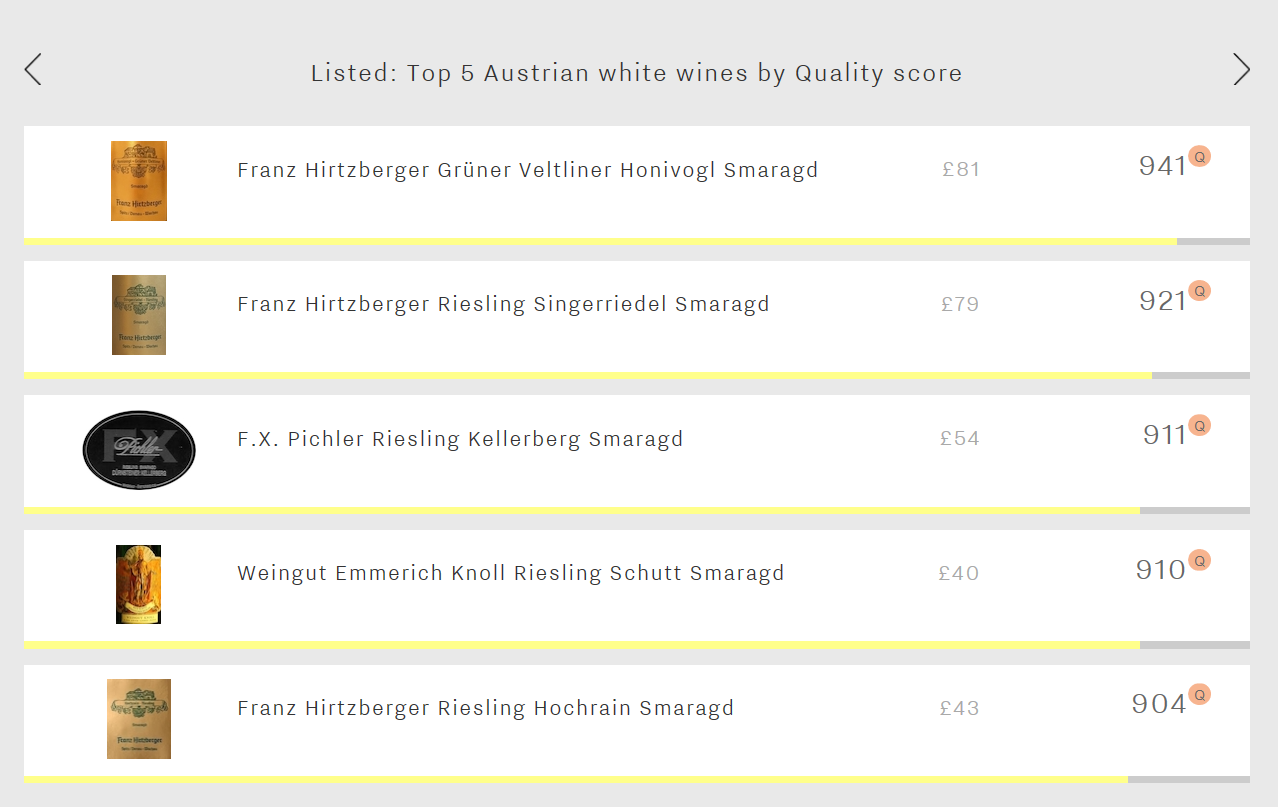
Notably, Franz Hirtzberger produces three of this week’s top five: his Grüner Veltliner Honivogl Smaragd, Riesling Singerriedel Smaragd, and Riesling Hochrain Smaragd demonstrating that he is indeed one of the greatest Austrian producers of dry whites. Leading the way this week is his Grüner Veltliner Honivogl Smaragd with a Quality score of 941. Interestingly, it is the only Grüner Veltliner of the group, with Austria’s national grape otherwise surrounded by Rieslings. At £81 per bottle, it is this week’s most expensive choice. However, it is also Jancis Robinson’s favourite of the five, Wine Lister’s UK partner critic awarding it an excellent average score of 18/20. She was particularly impressed by the 2013, giving it a rating of 18.5/20 and writing: “Spectacularly rich nose. Very ample, intense and flattering. Smoked meat! Kerpow! Not flabby. Great structure. Amazing”.
Franz Hirtzberger’s Riesling Singerriedel Smaragd comes next, and backs up its phenomenal Quality score (921) with this week’s best Brand score (760). Even though its Economics score is considerably lower (503), the Singerriedel is Austria’s overall top-scoring wine, with a Wine Lister score of 781.
F.X. Pichler’s Riesling Kellerberg Smaragd comes in at number three, with a Quality score of 911. This is Vinous’ favourite of the five with an average score of 95/100. Its Quality score is however pulled down slightly by its relatively low average wine life of seven years, making it the shortest-lived wine of the group (which averages nine years). However, it has the most stable price of this group, with volatility of just 2.7%, well below that of this week’s number one, Franz Hirtzberger’s Grüner Veltliner Honivogl, which has volatility of 11.8%.
The two remaining spots are filled by Weingut Emmerich Knoll Riesling Schutt Smaragd in fourth place, and the third wine from Franz Hirtzberger this week, his Riesling Hochrain Smaragd, in fifth place. Although the two come in last in this particular race, both still achieve excellent Quality scores (910 and 904 respectively), partly due to Vinous awarding both an average score of 93.5/100.
Wine Lister’s first in-depth study of Burgundy published earlier this year was named “Mercury Rising” for a reason. With prices climbing more quickly than any other fine wine region, it is hard to consider the possibility of finding Burgundies of “reasonable value”. This week’s Listed blog brings you the top five Côte de Nuits by Quality score that won’t completely rupture the bank (or in other words, for under £200).
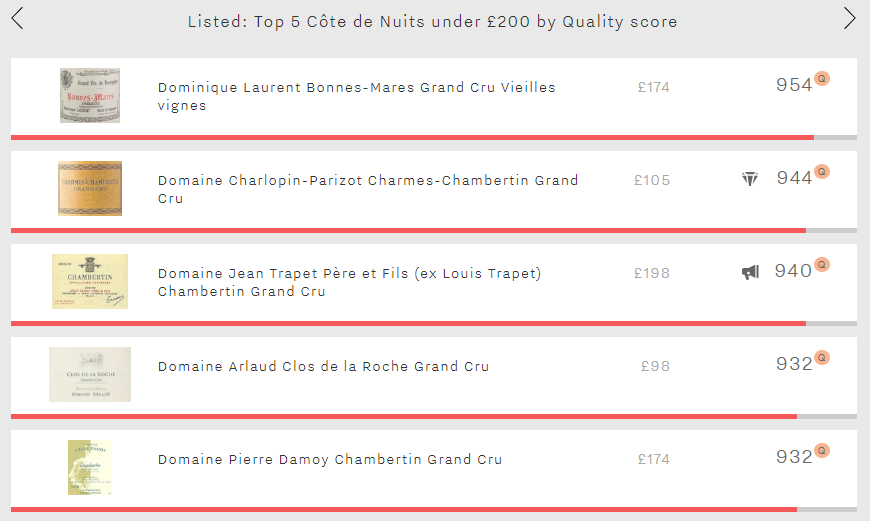
Dominique Laurent takes top spot this week with his Bonnes-Mares Vieilles Vignes, which has a Quality score of 954. Whilst this score sits comfortably amongst the highest of all Bonnes-Mares, the per bottle price of £174 does not – indeed, it is just under five times lower than the combined average price of the other eight best Bonnes-Mares on Wine Lister. Perhaps the lower price can, at least in part, be explained by its modest Brand score (531). For example, despite its Quality score sitting just one point higher, Georges Roumier’s Bonnes-Mares records a Brand score of 934, and is £1,046 more expensive.
In second place is Domaine Charlopin-Parizot’s Charmes Chambertin, with a Quality score of 944. Its high quality is not yet accompanied by an equal level of consumer recognition. With the lowest Brand score of the five (445) resulting from presence in only 2% of the world’s best restaurants and a search frequency ranking of 2,335 (of the c.4000 wines on Wine Lister), this Charmes Chambertin is a Hidden Gem (Wine Lister’s indicator that identifies under the radar wines that warrant discovery).
Domaine Jean Trapet Père et Fils’ Chambertin takes third place this week with a Quality score of 940 and just sneaking in under the £200 mark. While in third place for Quality, it has the highest overall Wine Lister score of the lot (906), thanks to its Brand (868) and Economics (896) scores. Indeed, it beats the combined average scores of the other four wines in this week’s top five in both categories by 310 and 319 points respectively.
The remaining two spots are taken by Domaine Arlaud Clos de la Roche, and Pierre Damoy Chambertin, each with a Quality score of 932. In addition to being by far the cheapest option of this week’s top five (£98 per bottle on average), Arlaud Clos de la Roche’s price is also the most stable, with volatility of just 5.7%. Conversely Damoy Chambertin’s price is the most volatile (8.7%), possibly the result of strong growth rates over both the long and short-term, having recorded a three-year compound annual growth rate of 15.6% and having added 6.5% to its price over the past six months alone.
This week, our Listed blog focuses on Spain’s strongest Brands. Unsurprisingly, and fittingly as we creep into autumn, all are red. It will probably also come as no shock that Bodegas Vega-Sicilia features prominently – filling an impressive three out of five spots on the list, including the top two.
Wine Lister’s Brand score combines a measure of a wine’s prestige – as indicated by its visibility in the world’s top restaurants – with its level of online popularity – calculated by ranking each of the 4000+ wines in our database by monthly search frequency on the world’s most visited wine site, Wine-Searcher. Four of this week’s top five also qualify as Buzz Brands – Wine Lister’s group of wines that perform particularly well when it comes to restaurant presence and online popularity, or are demonstrating a recent growth in popularity, and which are identified by the fine wine trade as trending or especially prestigious.
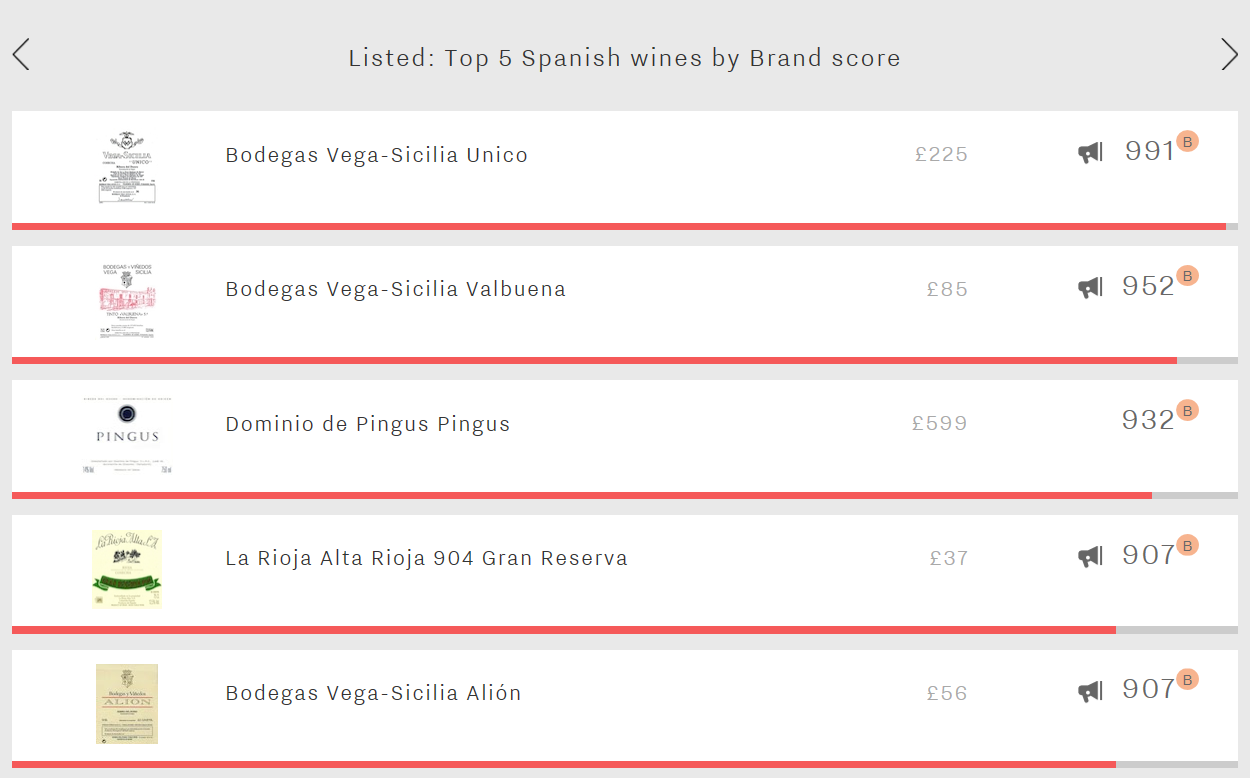
Vega-Sicilia Unico enjoys the best Brand score of any Spanish wine – and is thus the winner of this week’s race. In fact, it also achieves the highest overall Wine Lister score of all Spanish wines (974). Although Unico outperforms the rest of this week’s top five in all three of Wine Lister’s rating categories, its Brand score is particularly impressive (991). This phenomenal score is the result of excellent restaurant presence (47%) and being the 32nd most searched-for of Wine Lister’s wines on Wine Searcher.
Next, with a Brand score of 952 is Vega-Sicilia Valbuena. Despite not being able to match the Bodega’s flagship Unico in any category, it is in terms of brand recognition that it gets closest, its Quality and Economics scores trailing Unico by 115 and 54 points respectively. Its slightly lower – although still impressive – Brand score is the result of being visible in under half the number of restaurants as Unico (23%) and receiving fewer online searches (it is the 119th most popular wine on Wine Lister).
The third wine to make it onto the list is Dominio de Pingus Pingus. Presumably due to its tiny production volumes – only 6,000 bottles of it are produced each year – it is by far the most expensive of this week’s top five, at over twice the price of Unico (£599 vs £225). Its strong Brand – and high price – are supported by excellent Quality, with Pingus achieving the second highest Quality score of the group (935).
The last two places of this week’s top five are occupied by La Rioja Alta 904 Gran Reserva and Vega-Sicilia Alión. Not only do these two have identical Brand scores (907) but, despite contrasting profiles, they also share the same overall score (858). Alión achieves a higher Economics score (874 vs 729), whereas La Rioja Alta 904 records a slightly better Quality score (876 vs 812). La Rioja Alta 904 also shows that strong Brand and Quality scores do not necessarily have to mean soaring prices, as it is by far the most affordable of the five – priced at £37 per bottle on average.
It was with a heavy heart that the global fine wine trade learned of the passing of Barolo legend, Giuseppe Rinaldi, last week. Known for their elegant style and lengthy ageing potential, Rinaldi’s Barolos are not only some of the best that the region has to offer, but also some of the priciest.
In ‘Beppe’ Rinaldi’s honour, Wine Lister looks this week at the top five most expensive wines in Barolo. And there is good reason for these Barolos to be so pricey, with all of the five achieving a Quality score that falls into the “strongest” category on Wine Lister’s 1,000 point scale. On top of this, the first three qualify as Buzz Brands – Wine Lister’s group of wines that combine outstanding restaurant presence with online popularity.
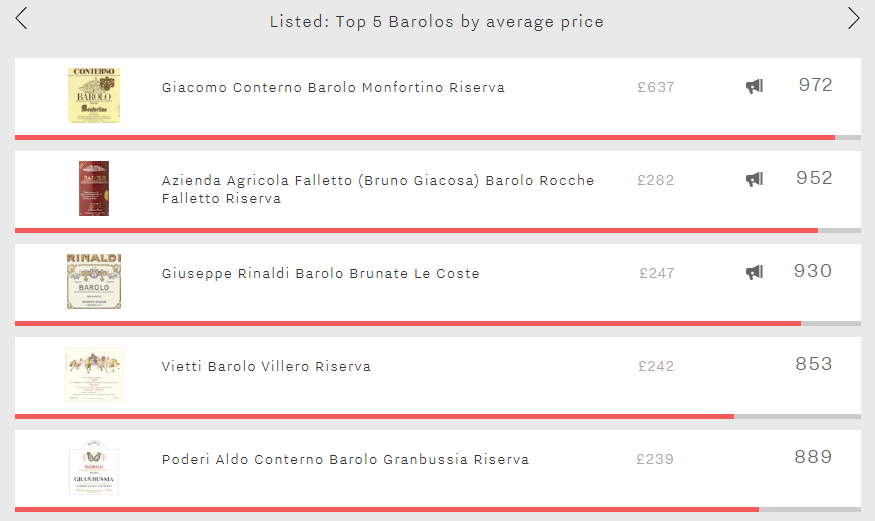
Giacomo Conterno’s Barolo Monfortino Riserva takes first place. At £637 per bottle it is more than twice the price of the rest of this week’s top five. In fact, it is the most expensive Italian wine on Wine Lister. However, it is no coincidence that Conterno’s Monfortino takes first place as it also achieves the group’s best Quality and Brand scores (977 and 969 respectively). Conterno Monfortino is actually the number one Italian wine and 11th best of all wines on Wine Lister, with an impressive overall score of 972.
This week’s second spot is occupied by Azienda Agricola Falletto (Bruno Giacosa) Barolo Rocche Falletto. Even though it competes well with Conterno Monfortino – with Quality and Brand scores of 974 and 914 respectively – it is a considerably cheaper option at £282 per bottle. In fact, despite its lower price, its Economics score is slightly superior to this week’s overall number one wine (969 vs 967), and is the group’s best. Furthermore, it is the second best of all Italian wines on Wine Lister – only beaten by Falletto’s Barbaresco Asili Riserva. The phenomenal Economics score is partly due to a three-year compound annual growth rate (CAGR) of 21.8%.
Giuseppe Rinaldi Barolo Brunate Le Coste takes third place at £247 per bottle. As perfect evidence of Rinaldi’s prowess, it is very consistent across each of Wine Lister’s three rating categories, with each score putting it amongst the very best wines in the world. Confirming its upward trajectory, it records a remarkable three-year CAGR of 36.7% – if it manages to keep that up, it will soon start to narrow the gap to Conterno’s Monfortino in this battle of the Barolos.
The two remaining wines in this group are not only very close in price but they also have the same Quality score (928). This week’s number four – at £242 per bottle – is Vietti Barolo Villero Riserva, followed closely by Poderi Aldo Conterno Barolo Granbussia Riserva at £239. Visible in 17% of the world’s top restaurants, Aldo Conterno’s Granbussia has the second-highest restaurant presence of the group. It is only beaten by this week’s number one, Conterno’s Monfortino, which is visible in 23% of top establishments.
As the Place de Bordeaux reawakens for September releases this week, Wine Lister examines some “place-distributed” wines from closer to home, namely the top five Bordeaux third growths by Wine Lister score. The successful 2009 and 2010 vintages in Bordeaux helped to coin the term “super seconds”, and despite a trickier en primeur campaign this year, these five wines make a good case for a new term: “thrilling thirds”.
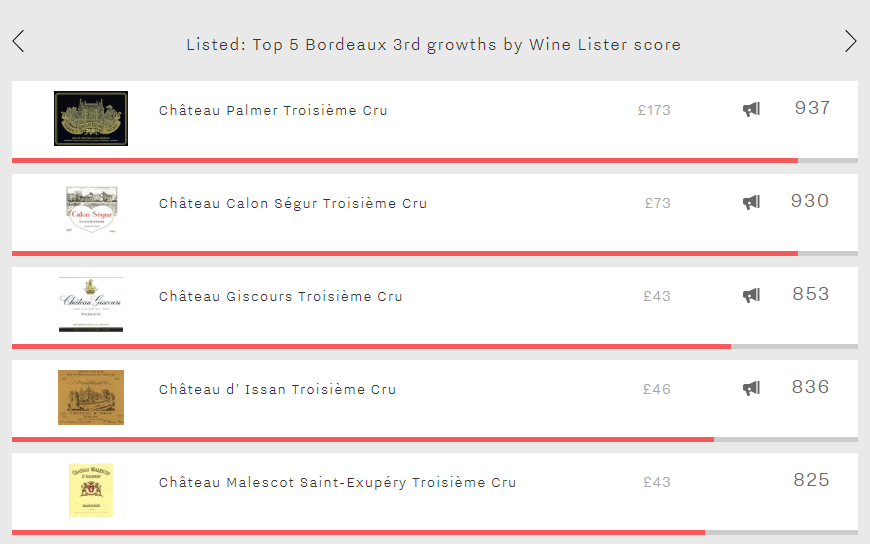
In first place, and one of the first out of the blocks for en primeur this year, is Palmer. With an overall score of 937, it is not only the best of this week’s top five, but also sits 69 points ahead of the average Bordeaux second growth Wine Lister score. Aside from its impressive Quality score (909), Palmer’s strength lies in its Brand, with a score of 995, thanks to presence in 47% of the world’s best restaurants, and being ranked 22nd out of all wines on Wine Lister for searches on Wine-Searcher.
Calon Ségur comes in second place, with an overall score of 930. It is the only Saint-Estèphe with third growth status, and the only one of this week’s top five not from Margaux (unsurprising, given that 73% of all Bordeaux left bank third growths hail from the appellation). Calon’s Economics score of 941 is the fifth-best of all Bordeaux left bank reds (beaten only by Carruades de Lafite, Château Margaux, Lafite, and Mouton). This is achieved through a three-year compound annual growth rate of 17% and short-term price performance of 8% – both the highest of this week’s top five.
Giscours is next with an overall score of 853. While Brand is its strongest score category (956), its Quality and Economics scores (804 and 782 respectively) still sit within the “very strong” section of the Wine Lister 1000-point scale. Furthermore, alongside Lynch Bages, Giscours was voted the most consistent seller (in volume terms) by the Place de Bordeaux in our 2018 Bordeaux Market Study.
The last two places of this week’s top five are taken by d’Issan in fourth place, and Malescot Saint-Exupéry at number five with scores of 836 and 825 respectively. The latter is the only one of this week’s top five that is not a Wine Lister Buzz Brand. As the least-known of the five, it might be considered the best value, with a Quality score of 811 and an average price of £43.
This week’s top five require absolutely no introduction. As Buzz Brands – Wine Lister’s group of wines that achieve outstanding online popularity and restaurant presence, and are also identified by the global fine wine trade as trending or especially prestigious – that is perhaps a given. Couple that with the fact that they hail from Bordeaux, and are the region’s most expensive Buzz Brands, it would be nigh on impossible for you not to be familiar with them to some degree.
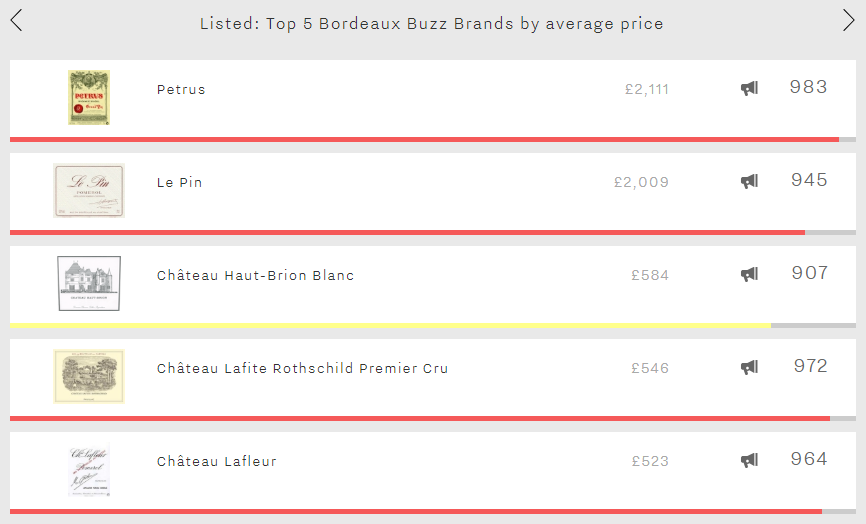
Pomerol is home to three of the five. With the limited production volumes of the plateau’s top wines, it is perhaps no surprise that they reach eye-watering prices. Petrus leads the way with an average price across all vintages of £2,111. It is Bordeaux’s best wine, and the fifth best in the world, its phenomenal score of 983 only bettered by Salon and three (!) DRC cuvées. Petrus is consistently brilliant across Wine Lister’s three rating categories with Quality, Brand, and Economics scores of 978, 998, and 972 respectively. It is worth focusing on its Brand score. Despite its relatively low production volumes, its rate of restaurant presence is outstanding. Visible in 45% of the world’s top establishments, and with more than five vintages / formats featuring on each wine list on average, it is clearly a wine that commands the utmost respect from sommeliers. Moreover, receiving over 60,000 online searches each month, it is well over five times as popular as its Pomerol neighbours Le Pin and Lafleur.
Le Pin comes next (£2,009). It enjoys Bordeaux’s second-best Economics score (979), pipped at the post by Carruades de Lafite (980). Its outstanding score comes courtesy not just of its high price, but also strong price performance, with a three-year compound annual growth rate (CAGR) of 17% and having added 8% to its price over the past six months alone. With those sorts of figures, it will soon overtake Petrus as Bordeaux’s most expensive wine – its neighbour having recorded a three-year CAGR of 13% but only managing to add 4% to its value since March.
At roughly a quarter of the price of Petrus and Le Pin, Lafleur is Bordeaux’s fifth most expensive Buzz Brand (£523). It was Bordeaux 2017’s top red for Quality, its score of 978 putting it just ahead of Petrus (971). Across all vintages it is also the longest-lived of this week’s top five, with Wine Lister’s partner critics predicting an average ageing potential of 21 years.
We cross over to the left bank for the group’s remaining two wines, the first of which might come as a slight surprise. Haut-Brion Blanc is Bordeaux’s third-most expensive Buzz Brand (£584). It is of course its rarity that propels it up the price tables. Producing just 6,720 bottles on average each year – 15 times fewer than Haut-Brion Rouge – it is over 60% more expensive than its red counterpart, despite trailing across each category.
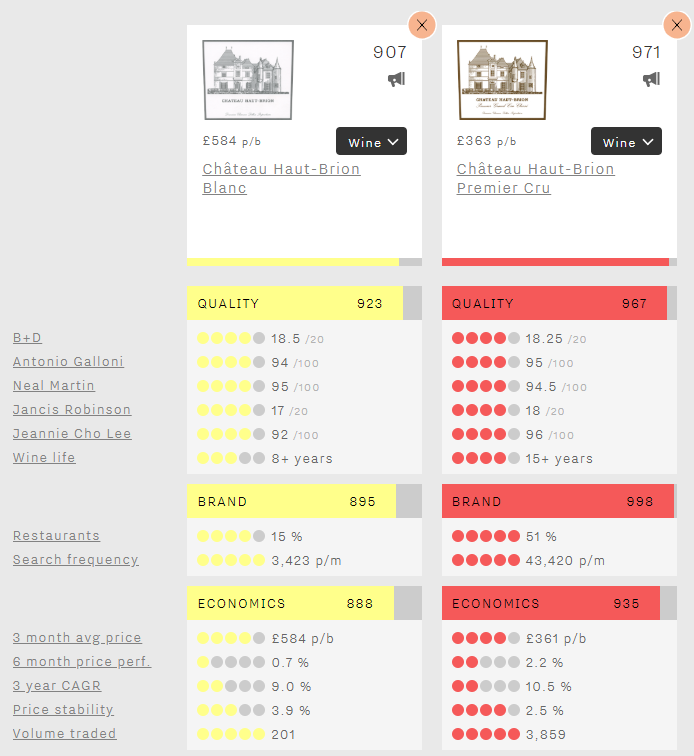
Rounding out the group – if it can ever be described as such – is Lafite (£546). With the best part of 200,000 bottles of it produced each year, it will come as no shock that it manages the best restaurant presence of the five, both in terms of the number of establishments in which it appears (54%) and the number of references per list (6.3 on average). It is also the most popular wine in the world, receiving over 80,000 online searches each month.
While wines made in The Golden State are not as affected by vintage variation as their European counterparts, the 2013 vintage was for California as close to perfect as they come. The long, hot summer led to Cabernet Sauvignons with extreme fruit concentration and firm structure – a recipe for long-term cellaring. The vintage’s economic credentials seem equally promising, with Economics scores of the top five Californian reds from the 2013 vintage outperforming their respective wine-level average by 114 points (averaging 979 in 2013 versus 864 across all vintages).
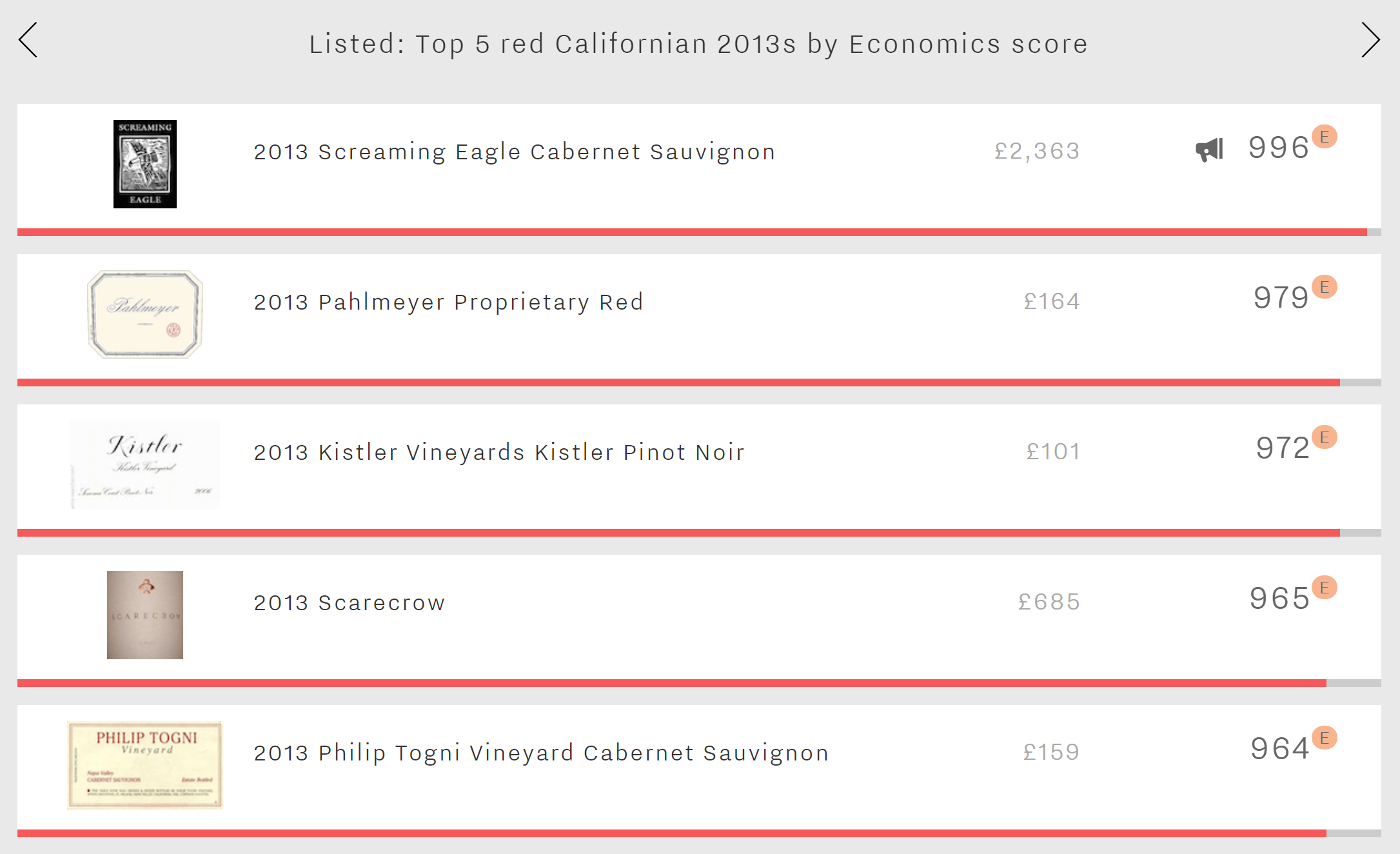
Perhaps unsurprisingly, the number one spot is taken by Screaming Eagle Cabernet Sauvignon. At 996, its Economics score is not only the highest of this week’s top five, but of all 2013s on Wine Lister (matched only by 2013 DRC Richebourg). It is also by far the most expensive of the five at £2,363 per bottle – over twice as high as the price of the other four combined. Screaming Eagle’s “mailing list” sales model teamed with tiny production quantities (7,800 bottles per annum on average) means that demand for this wine consistently outweighs supply. This could explain the wine’s strong presence on the secondary market, with 855 bottles traded at auction over the last 12 months (according to figures collated by the Wine Market Journal).
In second place is 2013 Pahlmeyer Proprietary Red. Interestingly, it has the lowest Quality score of the group. Indeed, its 2013 Quality score is 74 points lower than Pahlmeyer’s average (848). Contrastingly, the 2013 vintage receives its best ever Economics score of 979, boosted by a six-month price performance of 18.7%.
The third spot of this week’s top five is occupied by the only Pinot Noir of the group, Kistler Vineyards Pinot Noir, with an Economics score of 972. It is the only wine of the five to have been released before 2016, and thus the only one with a three-year compound annual growth rate (28.2%), whereas Economics scores for the other four 2013s are based upon price performance over the short term only. Kistler’s place in the top five 2013 Californian reds by Economics score is impressive, given its lower price point (£101 per bottle, compared with an £843 average for the other four wines).
The penultimate wine of this week’s top five is 2013 Scarecrow. Alongside its best ever Quality score (987), the 2013 vintage achieves an Economics score of 965, helped by the second-highest three-month average price (£663) and the best price stability of the group (with standard deviation of just 4.1% over the last 12 months).
Last but by no means least is Philip Togni Vineyard Cabernet Sauvignon, with an Economics score of 964. Though fifth for economics, it is number one for Quality, thanks to a 100-point score from Wine Lister partner critic, Antonio Galloni, who calls it “a majestic, towering wine… one of the wines of the vintage”.
A glass of cold Riesling on a hot summer’s day hits that sweet spot between refreshment, satisfaction, and intrigue. Any one of Germany’s finest wines for Quality under £300 would definitely deliver those three things. Moreover, with an average drinking window of 16 years, and with global warming seemingly set to deliver increasingly high summer temperatures, stock up on them now and you will be rewarded with stunning wines for years to come.

It is perhaps revealing of Riesling’s under-the-radar nature that three of this week’s top five qualify as Hidden Gems, meaning that they combine excellent critics’ ratings with modest restaurant presence and online popularity. Moreover, many of Wine Lister’s Hidden Gems were picked out by the global fine wine trade in our Founding Members’ survey, underlining the perennial mystery of Riesling as the darling of the trade, despite struggling to spark wide-scale consumer demand. Interestingly the group’s three Hidden Gems are all Beerenausleses (BAs). Schloss Johannisberg Rosa-Goldlack, Fritz Haag Brauneberger Juffer Sonnenuhr, and Weingut Robert Weil Kiedricher Gräfenberg’s BAs, in spite of a phenomenal average Quality score of 969, achieve an average Brand score of just 398 – the result of being present in just 2% of the world’s top restaurants and receiving only 70 online searches each month on average. Demand for excellent sweet Riesling is clearly not there at present.
However, returning to the group’s fantastic quality, it is Egon Müller’s Scharzhofberger Riesling Auslese that comes out on top with a score of 974. 2014 was its best ever vintage, with one of JancisRobinson.com’s critics, Michael Schmidt, awarding it 19/20 and heaping on the praise: “Our sensory perception is treated to an animating exuberance of exotic fruit and fresh raisins. Botrytis has been kept in check to focus on purity of expression rather than indulge in unctuous combustion”.
The group’s final spot is filled by Keller Westhofen Abtserde Riesling Grosses Gewächs (966). It is Jancis Robinson’s favourite of the five, achieving an outstanding average rating of 18.5/20 from Wine Lister’s UK partner critic. Tellingly, particularly in the context of the three BA’s lack of consumer demand, it is also the group’s most popular wine, receiving nearly 30 times more searches each month on average than the BAs. Consumers appear much more at ease with Riesling’s dryer styles.










